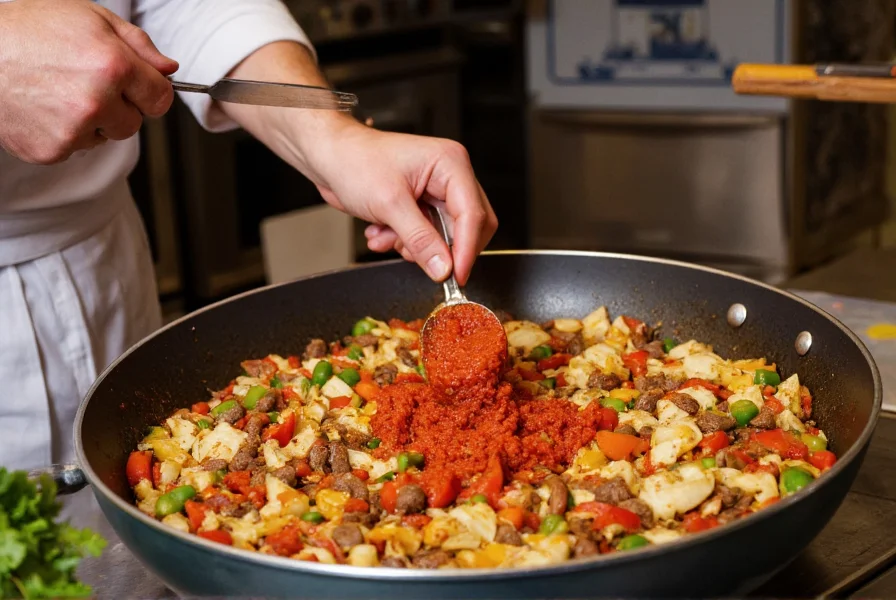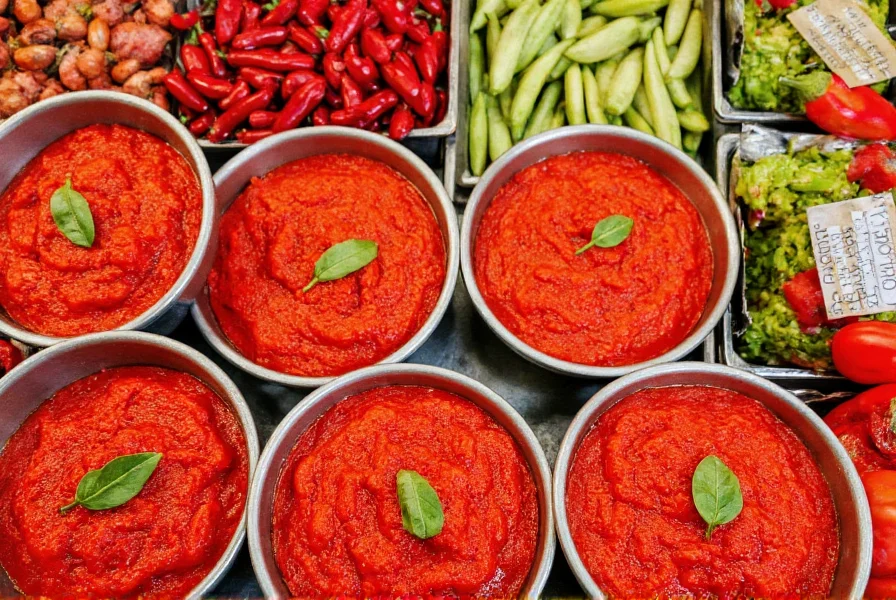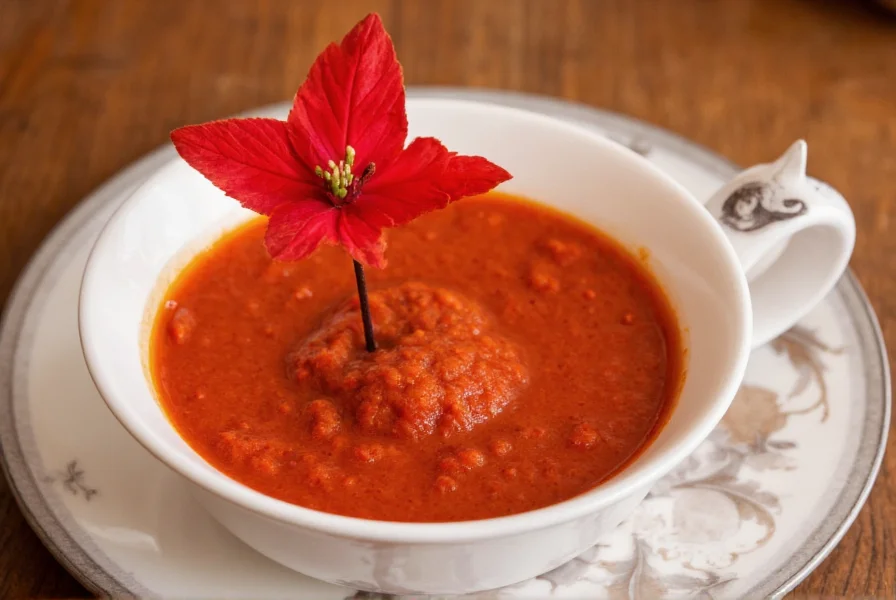Understanding red pepper paste unlocks new dimensions in your cooking. This vibrant ingredient transforms simple meals with its complex flavor profile ranging from sweet and smoky to intensely spicy. Whether you're exploring Korean gochujang, Turkish biber salçası, or Middle Eastern çemen, each variety brings unique characteristics to your culinary creations.
What Exactly Is Red Pepper Paste?
Red pepper paste represents a category of condiments created by grinding ripe red peppers into a thick, concentrated form. Unlike fresh peppers or dried flakes, the paste format delivers consistent flavor and easier incorporation into recipes. Production methods vary globally:
| Variety | Origin | Key Ingredients | Flavor Profile |
|---|---|---|---|
| Gochujang | Korea | Chili powder, glutinous rice, fermented soybeans, sugar | Spicy, sweet, umami-rich with fermentation depth |
| Biber Salçası | Turkey | Sweet red peppers, salt | Sweet, concentrated pepper flavor without heat |
| Harissa | Tunisia | Roasted red peppers, chili peppers, garlic, olive oil, spices | Spicy, smoky, garlic-forward with citrus notes |
| Çemen | Turkey | Red pepper flakes, paprika, cumin, garlic, olive oil | Spicy, earthy, with distinctive cumin notes |
Culinary Applications Across Global Cuisines
Professional chefs value red pepper paste for its ability to enhance dishes without overwhelming other ingredients. The paste's concentrated nature means a little goes a long way in building complex flavor foundations.
Korean cooking relies heavily on gochujang as both a cooking ingredient and table condiment. It forms the base for stews like budae jjigae, marinades for dakgalbi, and the iconic sauce in tteokbokki. Understanding red pepper paste vs gochujang is essential—while all gochujang is red pepper paste, not all red pepper paste qualifies as gochujang due to its specific fermentation process and ingredient composition.
Turkish cuisine features biber salçası as a fundamental building block. Chefs use this sweet red pepper paste to enrich tomato-based sauces, enhance meat dishes like kıyma, and create the base for egg dishes such as menemen. Unlike many spicy varieties, authentic Turkish red pepper paste typically contains no heat.

Practical Cooking Techniques
Mastering how to use red pepper paste in cooking requires understanding its behavior during preparation. The paste benefits from "blooming" in oil before adding other ingredients, which unlocks its full flavor potential. Here's how to incorporate it properly:
- For sauces and stews: Add 1-2 tablespoons to your oil base and cook for 2-3 minutes before adding liquids
- For marinades: Combine with oil, acid (like vinegar or citrus), and aromatics for tenderizing proteins
- As a finishing touch: Stir into finished dishes for vibrant color and flavor boost
- For dressings: Whisk with olive oil, vinegar, and garlic for instant depth
Storage and Shelf Life Considerations
Proper storage tips for red pepper paste ensure maximum freshness and flavor retention. Commercially prepared pastes typically contain preservatives that extend shelf life, while homemade versions require more careful handling.
Unopened jars maintain quality for 12-18 months in a cool, dark pantry. Once opened, transfer to an airtight container and refrigerate. Most varieties stay fresh for 3-6 months refrigerated. For longer storage, freeze in ice cube trays then transfer to freezer bags—this method preserves red pepper paste substitutes value when you need small amounts for recipes.
Effective Substitutions When Needed
Understanding red pepper paste substitutes proves invaluable when your recipe calls for it but your pantry falls short. The best alternative depends on which variety you're trying to replace:
- For gochujang: Mix 1 tbsp tomato paste + 1 tsp red pepper flakes + 1 tsp sugar + ½ tsp rice vinegar
- For Turkish biber salçası: Simmer roasted red peppers with a pinch of salt until thickened
- For harissa: Blend roasted red peppers with garlic, cumin, and olive oil
Remember that substitutions won't perfectly replicate authentic flavors but can provide similar functionality in recipes. The key is matching both texture and flavor profile as closely as possible.

Nutritional Profile and Health Considerations
Red pepper paste offers more than just flavor—it contributes valuable nutrients to your diet. Capsaicin, the compound responsible for heat in many varieties, has been studied for potential metabolic benefits. The paste format preserves more nutrients than dried pepper flakes since it avoids extensive dehydration.
A typical tablespoon (15g) serving contains approximately:
- 15-25 calories
- 1-2g carbohydrates
- 0.5-1g fiber
- Significant vitamin C and A
- Trace minerals including potassium and iron
When exploring korean red pepper paste recipes, note that gochujang contains fermented soybeans and rice, making it unsuitable for gluten-free or soy-free diets unless specifically labeled as such.
Creating Authentic Dishes with Red Pepper Paste
Master chefs recommend starting with simple applications to understand how red pepper paste transforms dishes. Try these beginner-friendly techniques:
- Stir 1 teaspoon into scrambled eggs for instant flavor complexity
- Whisk with olive oil and lemon juice for a vibrant salad dressing
- Add to tomato-based pasta sauces for depth without additional salt
- Use as a base for roasted vegetable glazes
- Mix with mayonnaise for an instant sandwich spread
As you gain confidence, experiment with traditional recipes like Korean bibimbap sauce, Turkish lahmacun topping, or Tunisian merguez sausage seasoning. The paste's versatility makes it equally valuable in quick weeknight meals and elaborate culinary creations.
Frequently Asked Questions
What's the difference between red pepper paste and crushed red pepper?
Red pepper paste contains ground peppers with moisture content, creating a thick, spreadable consistency that blends seamlessly into dishes. Crushed red pepper consists of dried, flaked peppers that add texture and immediate heat but don't integrate smoothly. The paste offers more complex flavor development through cooking, while crushed pepper provides instant spice.
Can I make red pepper paste at home?
Yes, you can create basic red pepper paste by roasting red bell peppers and hot peppers, then blending them with salt and a small amount of oil until smooth. For authentic gochujang, you'd need fermented soybean powder and glutinous rice, which requires specialized equipment and time. Homemade versions work well for immediate use but lack the depth of commercially fermented varieties.
Is red pepper paste gluten-free?
Most traditional red pepper pastes like Turkish biber salçası and harissa are naturally gluten-free. However, Korean gochujang typically contains glutinous rice powder, which may concern those with gluten sensitivity (though rice is naturally gluten-free, cross-contamination can occur). Always check labels if you require certified gluten-free products, as some commercial brands add wheat-based ingredients.
How spicy is red pepper paste?
Spiciness varies dramatically by variety. Turkish biber salçası uses sweet peppers and contains no heat. Korean gochujang offers moderate heat balanced with sweetness. Harissa and çemen range from medium to very hot depending on the peppers used. Always start with small amounts and adjust to taste, as the paste's concentrated nature means a little delivers significant flavor impact.
Can I use red pepper paste in place of tomato paste?
You can substitute red pepper paste for tomato paste in many recipes, but expect flavor and color differences. Red pepper paste adds heat and distinct pepper flavor while creating a deeper red-orange hue. For best results, use half the amount of red pepper paste and supplement with tomato paste or roasted red peppers. This works particularly well in stews, braises, and sauces where you want to add complexity without overwhelming tomato flavor.











 浙公网安备
33010002000092号
浙公网安备
33010002000092号 浙B2-20120091-4
浙B2-20120091-4